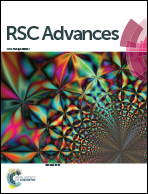New roles for metal–organic frameworks: fuels for environmentally friendly composites†
Abstract
Composite energetic materials are widely used in mining, air bag modules and propellants, and welding because they can release a large amount of stored energy on combustion. Unfortunately, common composite formulations exhibit incomplete combustion of these agents and their toxic components, reducing the yield and causing emission of harmful gaseous products. We report a new type of formulation using an energetic metal–organic framework, [Cu(atrz)3(NO3)2]n (atrz = 4,4′-azo-1,2,4-triazole), as an active component. Its physicochemical properties such as the decomposition temperature, heat of reaction, sensitivity, and gas generation rate were measured. Compared with traditional composites, these composites exhibit superior characteristics such as low toxicity, high peak pressure, insensitivity, and high activity, and they produce very little solid residue. In light of their excellent properties, they exhibit potential as green gas generators for future applications and open up a new field for the application of MOFs.



 Please wait while we load your content...
Please wait while we load your content...